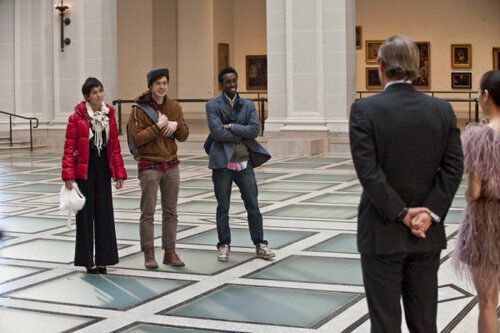
It's way off across the country relative to where I sit in Los Angeles, but last weekend the capital of the art world rested squarely in Florida, where Art Basel, Miami Beach shed its unconventional light upon god knows how many satellite art fairs. The headline in the Miami Herald? "Strong Art Basel Sales Signal Elite's Economic Recovery." Boy, I sure hope some of it trickles on down to me.
Of course when the mainstream media gets their claws into an art story (set aside the staff art critics, who are positioned way off at the spiral edge of any news organization anyhow), it's mostly about the money, with any column space left over reserved for the novelty of how in hell something that looks really dumb on the face of it turns out to be purchased for some ridiculous dollar figure. Here in film industry capital L.A. we're used to those Monday articles assessing the past weekend's movie box office leaders. But the collective judgment of about a million fans buying a $10 ticket, these sidebar novelty stories tell us, is one heckuva lot better than a few rich weirdoes willing to shell out the price of a house for a video of some woman with gold leaf hangin' off her face.
So the old story heats up as the high end of the art market begins to gather momentum: the decadent elite are taken for a ride by a bunch of con artists, versus the philistine hicks who think they understand what they know nothing about. Great news, it's all coming back, so let the good times roll!
The world that nearly all of the artists live in hardly resembles that of their collectors or many of their dealers. But when it comes to a uniquely prestigious fair like Art Basel, it's difficult to tell if more observers are fascinated by how it reflects the present state of art practice or that of the national economy.
Think about the average ticket buyer. For about the same amount of time you'd spend at a movie (and considerably longer if you prefer) you stroll past one mini-exhibition after another. Some things leave strong impressions, much is quickly ground up in the garbage disposal of your memory; overarching narratives of the encounter arise only to be replaced as you encounter more and more booths.
But this is not the experience of that tiny elite buying slice of the public, in particular those who attend prepared to drop six or seven figures on an individual artwork. These purchases are not a product of the whim of a chance encounter, at least not ordinarily. This is not window shopping, baby! And if you are an established dealer you've been in contact with a number of clients well in advance of the weekend. They are primed to expect you to be bringing in particular works by particular artists. If you are worth your salt you know what they covet, are bringing the merchandise to them, have made the proper restaurant reservations, and the weekend is well shaped well before the trip into town. The size of the crowd is less important than "the quality of the people" as so many dealers phrase it. They aren't speaking of their moral standards. We are talking about the playground for the rich.
Of course that is not the case for most dealers, particularly as you move out into the peripheral fairs. These folks and their artists are hoping to catch the eye of the more casual buyers and make enough cold sales to pay for the plane fare back home. With some luck, a few will attract the eye of a major patron or museum curator who can make a difference. Rather than bringing or meeting their contacts, their presence is driven by hopes of attracting attention and building a bridge to draw them closer to the main hall.
The real issue lurking behind the media caricatures and the dealers' networking is whether the bags of money stacked in the center of that playground correlate with the quality of the art that makes it in. And, let us assume that the finest of fine art attracts the biggest of big bucks. Is that how history is made?